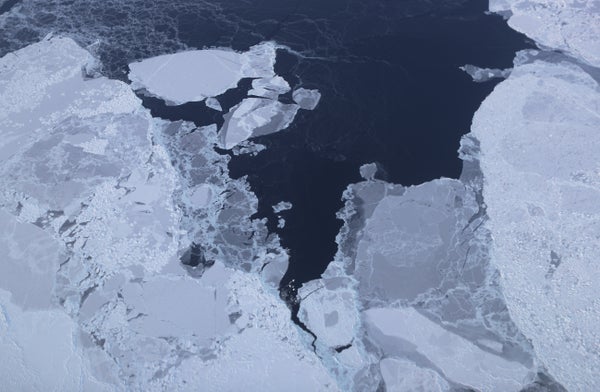CLIMATEWIRE | The 1987 Montreal Protocol is known best for saving the ozone layer. Now scientists say it also delayed the disappearance of Arctic sea ice.
The international agreement to phase out ozone-depleting chlorofluorocarbons is widely regarded as one of the most successful environmental treaties of all time. It effectively saved the Earth’s delicate ozone layer, which protects the planet from harmful ultraviolet radiation, and the “ozone hole” in the atmosphere is on track to fully recover within a few decades.
It also had unintended climate benefits. Chlorofluorocarbons are potent greenhouse gases, and global warming would have been significantly worse if they had stayed in use.
On supporting science journalism
If you're enjoying this article, consider supporting our award-winning journalism by subscribing. By purchasing a subscription you are helping to ensure the future of impactful stories about the discoveries and ideas shaping our world today.
That means the Montreal Protocol has helped slow the rampant melting of the Arctic, a new study finds. It’s likely already averted more than half a million square kilometers of sea ice losses, or nearly 200,000 square miles.
That doesn’t mean the treaty has saved the Arctic, the way it saved the ozone layer. The Earth is steadily warming, and the Arctic is heating up at around three times the global average rate. Sea ice has been dwindling for decades, and scientists estimate that the Arctic Ocean could see its first ice-free summer within a few decades or less. Some research suggests it could happen as early as 2035.
The new study, published in Proceedings of the National Academy of Sciences, finds that the treaty may have delayed the arrival of iceless summers by as much as 15 years.
Researchers Mark England and Lorenzo Polvani used climate models to investigate the long-term climate impact of the Montreal Protocol. They compared two scenarios in their simulations — one real-world scenario and one “world avoided” scenario, which simulates what would have happened if the Montreal Protocol had never existed.
It’s still uncertain exactly how quickly other greenhouse gases — carbon dioxide, in particular — will rise or fall in the atmosphere in the decades to come. That depends on the actions world leaders take to curb climate change.
The new study accounts for these uncertainties by applying two hypothetical greenhouse gas trajectories to their climate simulations.
The first is a “business-as-usual” scenario that assumes little to no climate action occurs between now and the end of the century. It’s a severe, although relatively unlikely, pathway. The second assumes moderate climate action in the coming decades, although not enough to meet the world’s climate target of preventing a temperature rise surpassing 2 degrees Celsius.
Under this moderate emissions trajectory, global temperatures would be nearly 1 degree Fahrenheit warmer by the middle of the century in a world without the Montreal Protocol. The study also finds that every metric ton of ozone-depleting substances the world has avoided because of the treaty has likely saved about 2,700 square miles of sea ice from melting.
The models indicate that the Arctic’s first ice-free summer would arrive about 15 years earlier in a world with no Montreal Protocol, compared to the real world.
The study doesn’t account for the most recent amendment to the Montreal Protocol, a 2019 update known as the Kigali Amendment. It aims to phase out the use of hydrofluorocarbons, a type of chemical that replaced chlorofluorocarbons after the Montreal Protocol went into effect. HFCs don’t destroy ozone, but they do warm the climate.
The Kigali Amendment is expected to prevent as much as 1 degree Fahrenheit of additional warming between now and the end of the century. But it’s happening too late to have much of an effect on ice-free summers in the Arctic, which are swiftly approaching, the new study notes.
It’s not the first study to point out the climate benefits of the Montreal Protocol. Other research has also concluded that the treaty has prevented a substantial amount of warming over the years — perhaps even more than the new study indicates. A 2021 paper in Environmental Research Letters estimated that global temperatures could be as much as 1.8 degrees Fahrenheit higher by the year 2050 if the Montreal Protocol didn’t exist.
Other scientists have looked specifically at the treaty’s effect on the Arctic. A 2020 study in Nature Climate Change suggested that ozone-depleting substances may have driven as much as half of all the warming experienced in the Arctic between 1955 and 2005.
The new study makes a similar case.
“Our findings clearly demonstrate that the Montreal Protocol has been a very powerful climate protection treaty, and has done much more than healing the ozone hole over the South Pole,” said Polvani, one of the two study authors, in a statement. “Its effects are being felt all over the world, especially in the Arctic.”
Reprinted from E&E News with permission from POLITICO, LLC. Copyright 2023. E&E News provides essential news for energy and environment professionals.
